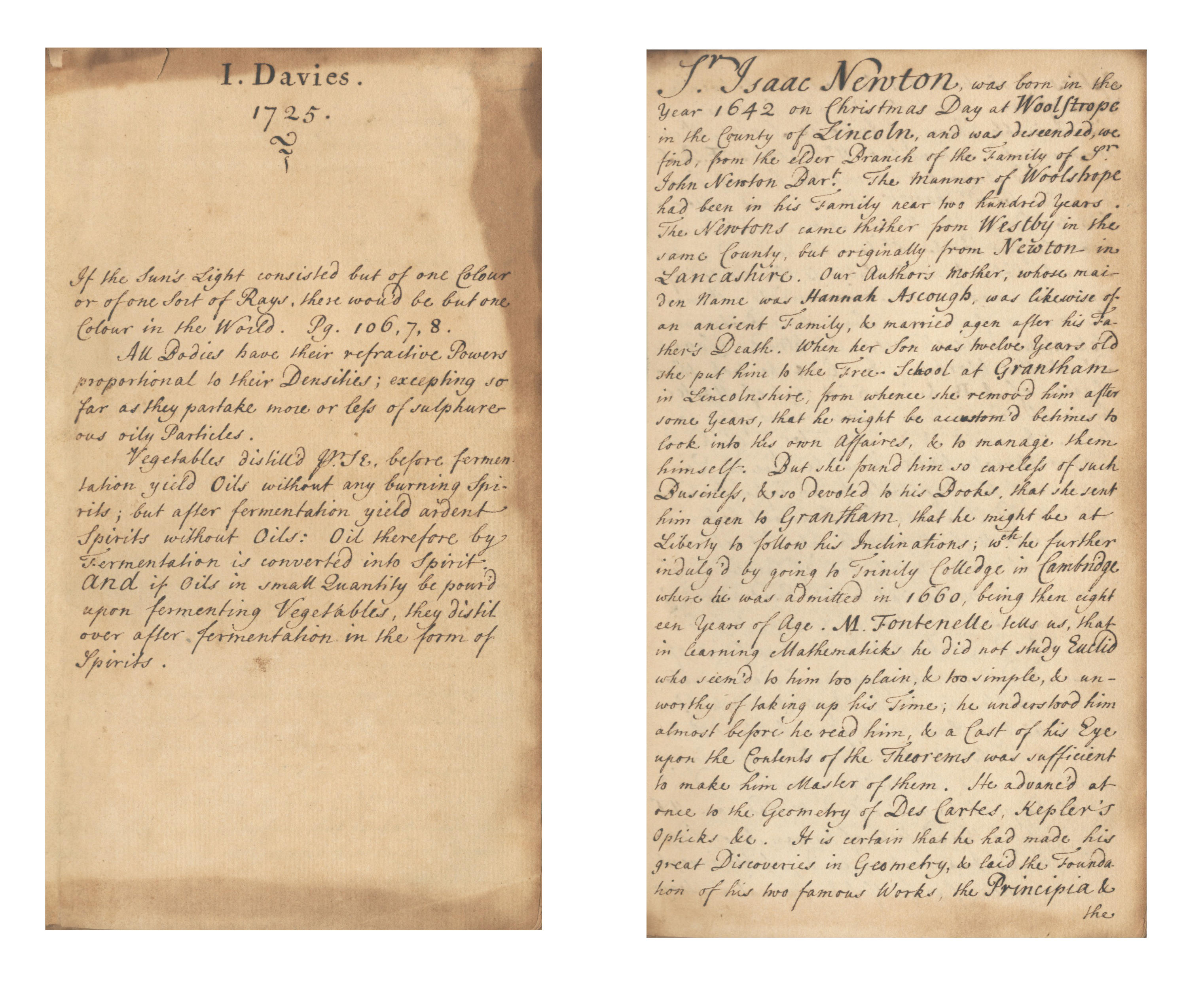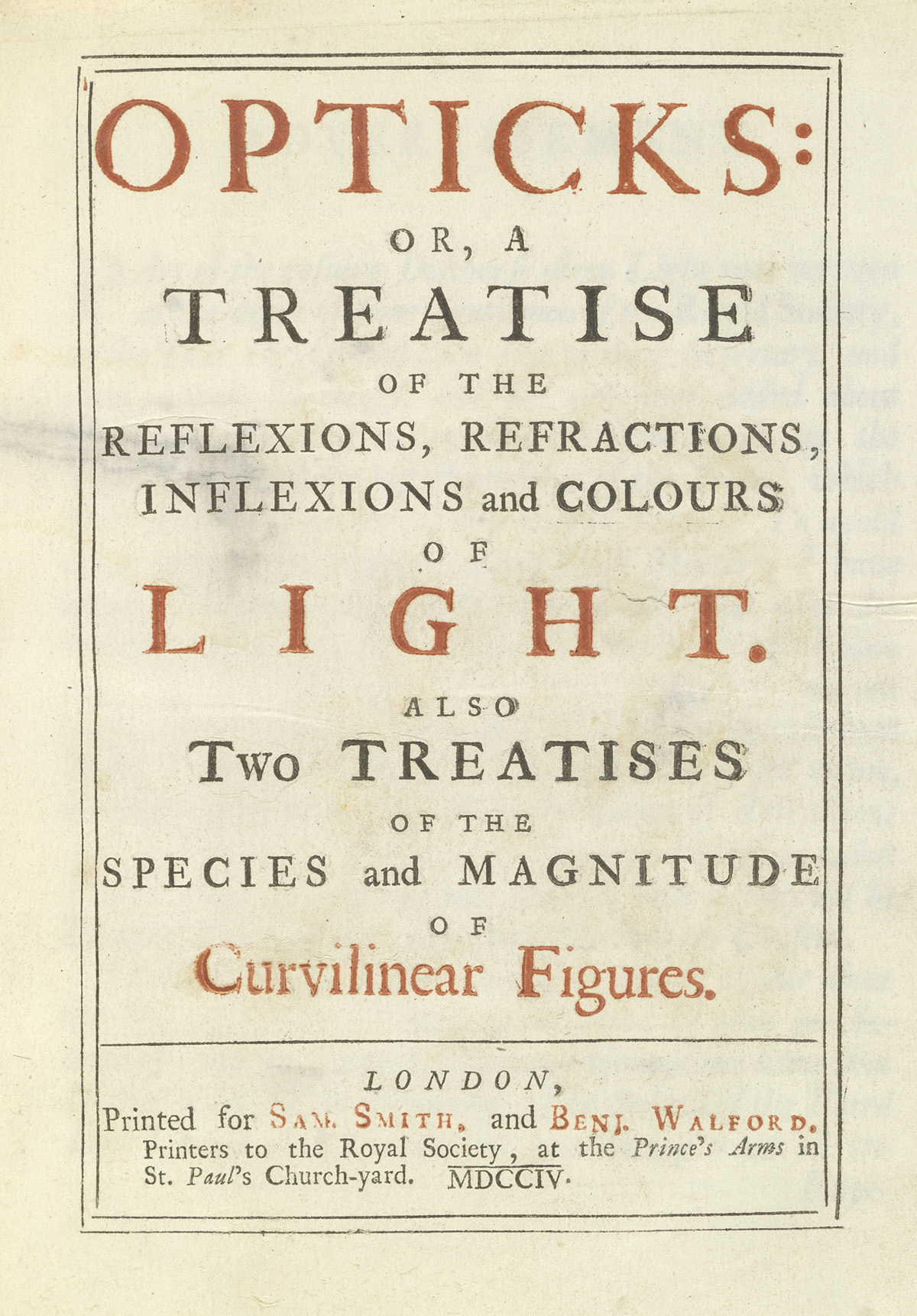NEWTON, Isaac, Sir (1642-1727). Opticks: or, a Treatise of the Reflexions, Refractions, Inflexions and Colours of Light. Also Two Treatises of the Species and Magnitude and Curvilinear Figures . London: for Samuel Smith and Benjamin Wolford, 1704. 4 o (240 x 194 mm). Title printed in red and black, 19 fold-out engraved plates. (Small marginal hole in Dd2, tiny wormtrack in lower gutter margins of last 2 quires, 2 small stains to last plate). Contemporary English blind-panelled calf, later morocco lettering-piece on spine, edges red-speckled (discreet restoration to head and tail of spine, corners and joints rubbed); morocco-backed folding cloth case. Provenance : contemporary manuscript corrections of errors listed on errata on 26 pages; John Ivory (18th-century signature), possibly the author of The Foundation of the University of Cambridge , Cambridge 1672; William Davenport Talbot (1764-1800) of Lacock Abbey, Chippenham, Wiltshire, father of William Henry Fox Talbot (inscription on front flyleaf: Davenport Talbot Laycock ). FIRST EDITION, containing Newton's fullest account of his discoveries and theories concerning the properties of light and color. Newton's construction of several reflecting telescopes from 1668-1672 brought him to the attention of the Royal Society, to which he was elected in 1672. During these years he experimented with prisms and other lenses, and by the mid-1670s he was planning a work on optics. His earliest publications on optical theory appeared in the Philosophical Transactions , beginning in 1671. Criticism of his arguments by Robert Hooke and others led to further experiments and a refinement of his theories. When Newton finally published the Opticks in 1704, he withheld his name from the title-page, signing only the preface with his initials. The most important results of Newton's mathematical and experimental investigations into the nature of light, recorded in the Opticks , are his analysis of white light as a compound of pure colors and his full explanation of the spectrum, his analysis of interference effects, and the discovery of periodicity, which was to lead to wave theory. "For over a century [the Opticks ] remained a work of great authority, 'supreme' in Andrade's words, 'as a record of experiment and scientific deduction from experiment'" (PMM). This edition has additional importance because it contains the first two of Newton's mathematical papers to be published, included in order to affirm Newton's priority over Leibnitz in the discovery of the calculus. A FINE COPY WITH INTERESTING PROVENANCE. Babson 132; Dibner Heralds of Science 148; Grolier/Horblit 79b; Norman 1588; PMM 172; Wallis 174.
NEWTON, Isaac, Sir (1642-1727). Opticks: or, a Treatise of the Reflexions, Refractions, Inflexions and Colours of Light. Also Two Treatises of the Species and Magnitude and Curvilinear Figures . London: for Samuel Smith and Benjamin Wolford, 1704. 4 o (240 x 194 mm). Title printed in red and black, 19 fold-out engraved plates. (Small marginal hole in Dd2, tiny wormtrack in lower gutter margins of last 2 quires, 2 small stains to last plate). Contemporary English blind-panelled calf, later morocco lettering-piece on spine, edges red-speckled (discreet restoration to head and tail of spine, corners and joints rubbed); morocco-backed folding cloth case. Provenance : contemporary manuscript corrections of errors listed on errata on 26 pages; John Ivory (18th-century signature), possibly the author of The Foundation of the University of Cambridge , Cambridge 1672; William Davenport Talbot (1764-1800) of Lacock Abbey, Chippenham, Wiltshire, father of William Henry Fox Talbot (inscription on front flyleaf: Davenport Talbot Laycock ). FIRST EDITION, containing Newton's fullest account of his discoveries and theories concerning the properties of light and color. Newton's construction of several reflecting telescopes from 1668-1672 brought him to the attention of the Royal Society, to which he was elected in 1672. During these years he experimented with prisms and other lenses, and by the mid-1670s he was planning a work on optics. His earliest publications on optical theory appeared in the Philosophical Transactions , beginning in 1671. Criticism of his arguments by Robert Hooke and others led to further experiments and a refinement of his theories. When Newton finally published the Opticks in 1704, he withheld his name from the title-page, signing only the preface with his initials. The most important results of Newton's mathematical and experimental investigations into the nature of light, recorded in the Opticks , are his analysis of white light as a compound of pure colors and his full explanation of the spectrum, his analysis of interference effects, and the discovery of periodicity, which was to lead to wave theory. "For over a century [the Opticks ] remained a work of great authority, 'supreme' in Andrade's words, 'as a record of experiment and scientific deduction from experiment'" (PMM). This edition has additional importance because it contains the first two of Newton's mathematical papers to be published, included in order to affirm Newton's priority over Leibnitz in the discovery of the calculus. A FINE COPY WITH INTERESTING PROVENANCE. Babson 132; Dibner Heralds of Science 148; Grolier/Horblit 79b; Norman 1588; PMM 172; Wallis 174.
.jpg)
.jpg)
.jpg)
.jpg)











Testen Sie LotSearch und seine Premium-Features 7 Tage - ohne Kosten!
Lassen Sie sich automatisch über neue Objekte in kommenden Auktionen benachrichtigen.
Suchauftrag anlegen